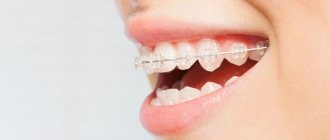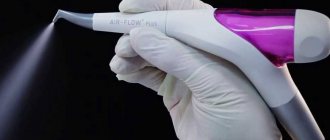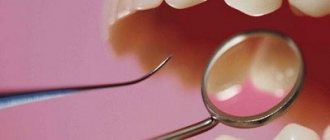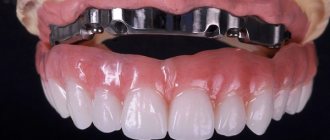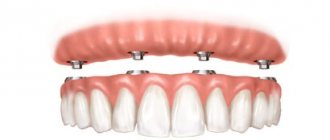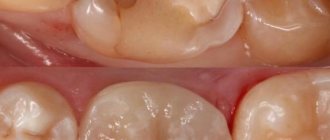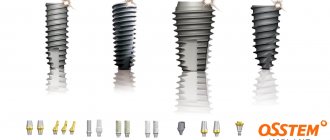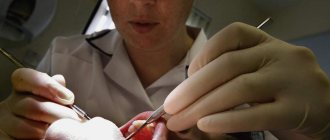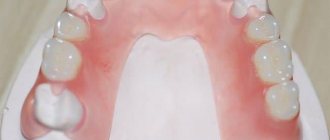Incorrect position of the fangs is one of the most common malocclusion pathologies. Crooked fangs not only spoil a smile, sometimes giving it a “vampire” look, but also interfere with the ability to fully chew food. In other situations, it is necessary to pull the impacted fang out of the gums. Only a specialist, based on a visual examination and x-rays, can decide to put braces on the fangs or use other orthodontic devices. We will look at the causes, types of anomalies and briefly talk about how to correct the situation.
What are each type of teeth?
Let's take a closer look:
- The incisors are the front teeth in the middle of the jaw. They only have one root. They have an external convex and internal, slightly concave surface, as well as small tubercles at the base. They are intended primarily for tearing food into separate pieces (biting off). Due to their sufficient weakness, they are practically not suitable for chewing.
- The canines follow in a row behind the incisors, located in the corners of the jaws. They are equipped with the longest root and crown, so they are quite strong.
- Premolars are located behind the canines. Their chewing surface is much wider and has 2 tubercles for chewing. Children do not have such teeth.
- Molars are the largest size. They are designed to grind food. There are three to five chewing tubercles on the surface.
What pathologies can be corrected?
Bite pathologies are different and may require different approaches to treatment. Let's consider the main types of defects:
- Open bite - lack of closure of the upper and lower teeth (mainly the front teeth). It will be more effective to treat this problem in childhood, but adults can also get rid of it. Treatment of open bite is not easy and often requires an integrated approach, including surgical methods.
- Deep bite - the lower row of teeth is partially or completely hidden under the upper one. In this case, the enamel of the upper teeth usually wears off quickly. To correct this type of bite with braces, the lower dental organs are covered with special overlays designed to increase the bite. After they are removed, orthoelastics are attached to the braces to improve contact between the teeth.
- Crossbite is one of the rare types of defects. With it, during the closure of the jaws, the teeth of the upper and lower jaws intersect. Teeth in such a situation may have abnormal sizes. The rows can narrow or widen, giving facial asymmetry. Often, when eliminating this problem, it is necessary to remove some teeth and then treat the bite with braces.
- Mesial bite - the teeth of the lower row are moved forward relative to the upper. Patients with this problem have a strongly protruding chin and distorted speech. In simple cases, this pathology can be cured with braces. However, surgery will be required to change the size and position of the jaw.
- Distal overbite is a strong protrusion of the upper jaw over the lower jaw. The mouth of a patient with this problem is constantly open, and there is a fold on the chin. In severe cases of this anomaly, surgical treatment methods are used. In lighter ones, leveling structures can cope with them.
- Diastemas (gaps between the two front incisors of 1-6 mm) and trema (gaps between other teeth except the two front ones). Treatment is carried out using braces or by hiding the defect with veneers or crowns.
- Crowding of teeth is the most common anomaly. It consists of teeth erupting outside the dental arch, overlapping them, and being in an unfolded state. Simple cases of this pathology can be corrected with braces in six months. Sometimes some “interfering” teeth have to be removed (mostly wisdom teeth).
Anomalies in the development of the dentition
Most often, if we consider all types of teeth, anomalies of an orthodontic nature occur in the canines. Many patients turn to specialists to correct the incorrect position of these teeth. Curvature of the fangs is observed in every third patient of orthodontists.
Types of curvature (dystopia) of fangs:
- fangs protruding from the jaws;
- hidden behind other teeth;
- very short or long;
- expanded;
- did not cut through completely.
The anomaly of the fangs “vampire smile” not only spoils the aesthetic side of the smile, but also interferes with the correct implementation of the function of eating. In this case, they seem to support the corners of the mouth. Braces can be a great solution to this problem.
Types of anomalies
The canines are located behind the incisors in the front corners of the upper and lower jaw, have a crown and a fairly long root, which makes them one of the strongest teeth in the oral cavity.
Orthodontists identify the most typical types of anomalies of row elements:
- Fangs that have not fully erupted , which prevents them from fulfilling their functional purpose, which is to break the fibers of the food they eat.
- The size is too large or short , affecting the deterioration of the bite.
- The location of the fangs, in which they are covered by other teeth and are located on the side of the mucous membranes of the mouth, in which they lose the ability to work in accordance with their functional purpose.
- Fangs turned in different directions along the vertical axis relative to the normal position of the elements in the jaw are considered defects that worsen the appearance of the patient’s smile area.
Note! One of the most unaesthetic types of curvature is a situation in which these teeth protrude from the jaws where they are located, forming the so-called “vampire smile”.
Its characteristic feature is that the protruding elements seem to support the anterior corners of the oral cavity.
In this case, as prescribed by orthodontists, bite correction with braces is indicated.
The need to straighten, pull out a fang or correct an incorrect position of an element in the jaw using braces is determined by the dentist for each patient individually after assessing the nature and severity of the disease.
Why and do braces always rub your cheeks, what to do in such a situation.
Come here if you are interested in the difference between staples and braces.
At this address https://www.vash-dentist.ru/ortodontiya/breketyi/vestibulyarnyie/shataetsya-zub.html we will find out why and how long a tooth is loose under braces.
Treatment options for canine dystopia
It is quite easy to determine canine dystopia. The complexity of its treatment depends on how advanced the disease is, the age of the patient and the nature of the anomaly.
Main methods of treatment:
- remove a wisdom tooth (when its growth is the cause of the anomaly);
- the use of braces (often you have to remove one of the teeth, usually a premolar, and then the canine is moved to the right place);
- installation of a prosthesis, or transformation of the first premolar into a canine (if it is missing in the row);
- reposition in more severe situations.
Note: The earlier treatment begins, the greater the likelihood that the patient will retain all teeth. For children under 12 years of age, removable plates are used for alignment, and teeth that are not fully formed are quickly aligned (in three to six months).
Teenagers aged 14-15 years old can benefit from braces very well without the need for surgical intervention, but in most cases such intervention is necessary for adults.
How dentists fight dystopia of “eye” teeth
Determining the curvature of the fangs is quite simple - to do this, the dentist just needs to examine the condition of the client’s oral cavity. When choosing a treatment method, the following criteria are taken into account:
- patient's age;
- features of the existing anomaly;
- degree of neglect of dental pathology.
To remove the curvature and force the canine into the correct position, the doctor may resort to the following treatment options:
- installation of braces on fangs;
- use of mouth guards;
- removal of “eights” (necessary if they are the cause of a dental anomaly);
- transformation of the first molar into a canine if the latter is missing;
- reposition (used exclusively in the most severe cases).
The sooner treatment of the curvature is started, the higher the likelihood of its complete elimination in a short time.
If we are talking about providing orthodontic care to children under twelve years of age, then they are advised to wear removable plates. Typically, this method can achieve a beautiful smile in early adolescence in just six months. This is interesting: The subtleties of splint therapy in dentistry - the price, the essence of the technique Teenagers fourteen years of age and older can return the fang to the place allocated for it by nature using braces. Adults often have to not only wear braces, but also undergo a simple surgical operation.
Treatment tactics
According to medical statistics, canine dystopia is one of the most common malocclusions.
After examining the patient and taking an x-ray of the patient’s jaw, depending on the stage and type of disorder, as well as the patient’s age, the dentist recommends one of the following methods for eliminating the pathology:
- Extirpation of a wisdom tooth is performed in cases where it is established that it was the growth of this element of the row that caused the appearance of the disorder.
- Installing a prosthesis allows you to correct the position, but is a fairly expensive option for correcting your bite.
- Treatment of the first premolar, which is the tooth next to the canine, to convert it into a canine, is used when there is no natural unit in the series.
- Tooth repositioning is a procedure performed using local anesthetics and designed to return the element to its original position, for example, after dislocation.
- The purpose of correcting the position using braces or other orthodontic devices, before which it is necessary to perform an extraction, then move the canine to its proper place and fix it with removable structures.
Important! Dentists note that when choosing methods for correcting the disorder, orthodontists take into account the fact that removable plates are excellent for correcting malocclusion in children under 12 years of age. With their use, the position of developing teeth is corrected within 12–25 weeks.
The optimal case for prescribing braces is to eliminate dystopia in adolescents aged 14–15 years, since in patients of older age groups, the use of this method without prior surgical intervention will not provide the desired effect.
In some cases, if the patient does not want to install braces, the orthodontist may recommend replacing them with removable aligners or veneers.
The former have a longer period of correction of the anomaly, and the latter can be used in the absence of functional changes in the pathological element.
Why can such teeth be crooked?
The canines are the last to erupt. They appear in a child at the age of 9-12, when all the other teeth have already erupted and taken a certain place. Sometimes there is simply no place for fangs in the dentition; it may already be occupied by another dental organ. Then the eye teeth can grow outside the dentition, dystopia is formed.
Another reason for the curvature of the fangs is their discrepancy with the size of the jaw. When a child inherits large teeth from one parent and a small jaw from another, canine anomalies occur quite often.
Anomalies can also be caused by untimely replacement of baby teeth with permanent ones.
Why do fangs grow incorrectly?
There are several reasons for the formation of an anomaly. Most often, crooked fangs occur as a result of two main factors.
- Late eruption. They usually appear between the ages of 9 and 12, at a time when all other teeth have already confidently taken their places. Sometimes they simply do not have enough space in the dentition, and they look for a way out elsewhere. Crooked fangs in this case are a sign of dental dystopia.
- Another common reason is a discrepancy between the size of the jaw and dentition. That is, the anomaly can be formed as a result of a small jaw and large teeth.
In this case, the anomaly can manifest itself in different ways:
- fangs “hide” behind other teeth;
- curves turned in different directions;
- too long or, conversely, short;
- an impacted fang stuck in the gums.
The leveling process in each individual case will occur according to an individual scheme, depending on the nature of the pathology and its severity. When teeth impaction occurs, its own treatment methods are also used. You can see one example of pulling out a fang using braces in the following video.
How does alignment happen?
It usually takes 2 years to return the fang to its place with the help of braces.
It is important in such a situation to free up space for the fang by widening the jaw or getting rid of a poorly functional tooth.
If the second and fourth teeth are too close together, the quads are most often removed. When the fang only slightly protrudes from the dentition, removal is not required; in this case, it is enough to widen the jaw and at the same time move the dental organs to the right place.
Both regular metal braces and more aesthetic ones (lingual, ceramic, sapphire) can be used to straighten fangs.
It is important to start treatment as early as possible to avoid unpleasant consequences.
How does the process work?
On average, the process of returning the fangs to the correct position will take approximately two years. It has long been noticed that the appearance and profile of the face with and without braces for correcting fangs is significantly different. This is due to the functional load performed by canine teeth. In this case, the orthodontist faces the very important task of allocating free space for the fangs. To do this, as a rule, extra teeth are removed.
If there is not enough space between the second and fourth, then, as a rule, they resort to removing the fourth (or fifth, sixth) tooth. If a minor defect is visible in the protrusion of the fang from the general row, then removal will not be necessary. The bracket system will easily correct such a displacement. Braces expand the jaw and move the tooth into the desired position.
For fangs, ordinary metal braces and other more aesthetic materials (ceramic, sapphire and others) are used.
Is it possible to fix fangs without braces?
Many patients refuse to use braces. Reasons for refusal, in addition to the aesthetic component of this treatment method, may be the following:
- high cost of design and procedures related to treatment;
- long duration of treatment;
- difficulty to predict the result;
- long period of rehabilitation.
Fangs can also be corrected using other methods. Which one is better suited in a particular situation depends on the complexity of the anomaly and the age of the patient.
Correcting an overbite for children is much easier than for adults. Therefore, there are more ways to achieve this goal.
Alternatives to correcting fangs with braces in children:
- using mouth guards at night;
- the use of soft plates that are removable are quite easy to maintain, but treatment with them will take longer;
- trainers - have a targeted effect on problem teeth, are easy to use, and quite effective (since they are made for a specific defect, which can be corrected much quickly).
For an adult who has serious bite problems, it is better to use braces. Only in cases where the pathology is minor can other treatment methods be used. Such as:
- the use of removable aligners - does not affect the appearance of the smile, they need to be used for 1.5-3 years;
- veneers - used for minor pathology affecting only the appearance, if necessary, quickly correct it; These are thin plates attached to the teeth, do not cause discomfort, are almost invisible, but do not solve the problem itself, improving only the appearance.
The doctor decides whether to use braces to treat the bite or use alternative methods. After a thorough examination and obtaining the necessary results, he applies one or another method.
Whatever structures are used by the patient for treatment, he needs to constantly visit a doctor who will advise and monitor the correct course of the treatment process.
Reasons not to use braces
Most often, bite correction in adults without braces is used when an impeccable appearance is required. For example, it is unacceptable to wear even a transparent system at work.
Deterioration of diction when installing braces is also a reason for refusing them. To be fair, it should be said that it can be put in order with speech exercises.
During frequent conversations, the locks of the braces strongly rub the mucous membrane, and you have to fight the pain. To reduce pain, wax is used that is stuck to the locks, but not every person is ready to put up with pain and discomfort. Correcting a bite without braces does not cause much pain
This is especially important if you have a low pain threshold. Constantly being on painkillers is not much fun
It is also worth correcting teeth without braces when only one or two teeth are incorrectly positioned, or the bite differs slightly from the norm. Here, installing a system simply does not make sense.
If you are allergic to metal, then you need to correct crooked teeth without braces, because metal is an integral part of braces. Braces also require special care and avoidance of certain types of solid foods. There is nothing complicated here, but if these conditions are unacceptable for you, below we will tell you whether it is possible to straighten your teeth without braces.
And finally, teeth correction without braces is used to change the bite in childhood, and to prevent defects in children under 12 years of age.
The causes of curvature are different. Most bite problems develop during the early development of a child and can be eliminated without the use of braces at different ages. For example, the cause of the problems is a genetic predisposition, excessive pacifier addiction at an early age, or a lack of solid food in the baby’s diet, which causes the jaw muscles to begin to weaken and the dentition to become crooked.
Correcting the position of fangs with braces
Placing the fangs in the right place and aligning them takes 1-2 years of treatment with braces. This procedure sometimes requires removing one tooth from a row or widening the jaw, thus freeing up the necessary space. For minor curvatures, these procedures do not have to be resorted to.
You can use different braces to straighten your fangs: metal, ceramic, lingual or sapphire. It is better to carry out this treatment in adolescence. This way, the result will be achieved much easier and faster.
Braces can be installed only on the fangs, if there is no curvature of other teeth. It will take several years of treatment to straighten the fangs in such a situation.
You can straighten protruding fangs, depending on how severe the pathology is and its characteristics, in different ways.
Let's consider the average treatment option:
- First you need to cure all organs of the oral cavity, get rid of caries, plaque and stone.
- Then they examine the oral cavity, make impressions, and take x-rays. With their help, the structure is made.
- In order to free up space, the jaw is expanded if necessary or some teeth are removed.
- Next, the braces are installed.
- After the result is achieved, the braces are removed and retainers are selected for the patient. To secure the result, he will need to wear them for some time.
Treatment technique
For protruding fangs, a certain alignment technique was invented:
- Professional cleaning, which is recommended to be carried out by a hygienist. Here, plaque accumulated over many years is not only cleaned, but the health of the gums is also checked, the enamel is polished and the necessary recommendations are given.
- Sequential fixation of braces.
- Sliding the top row to obtain the necessary space.
- Moving the canines to the vacant space and stabilizing the incisors.
- Wearing orthoelastics, which provide good interdental contact. Wearing elastics is indicated 12 months after installing braces.
- Retention period.
The return of the dental fangs to the right place occurs in the fifth month of treatment. One of the arches holds the incisors in the correct position.
Pros and cons of orthodontic construction
Braces have the following advantages:
- With their help, you can cope with almost any jaw anomaly, regardless of the stage of curvature.
- There are practically no contraindications to their use.
- Already in the first months of treatment, the result is noticeable.
- Suitable for both adults and children.
- The installation procedure takes place exclusively in a dental clinic. The patient himself does not need to take them off and put them on, since the design is non-removable.
- The latest developments in braces are almost invisible to others.
Disadvantages of designs:
- The need for more thorough oral hygiene. In addition to teeth, braces also need to be thoroughly cleaned to prevent diseases such as caries, periodontitis and gingivitis from developing. This procedure should be performed after every meal.
- Long-term wearing design.
- Aesthetic side. Not all braces look attractive. But there are many of them that are practically invisible on the teeth (ceramic, lingual).
- High price when compared with other correction systems.
General recommendations
You need to understand that not only the orthodontist who installs braces on the fangs is responsible for the result of treatment. A lot depends on the patient himself, his responsibility and strict adherence to the established rules. During treatment, you should adhere to two mandatory points:
- Compliance with all rules of daily care of teeth and braces.
- Mandatory use of elastics according to the scheme indicated by the doctor.
Daily hygiene using special orthodontic instruments is one of the conditions for maintaining healthy teeth under braces. Some dentists even refuse to install braces on patients who do not take good oral care. The fact is that only thorough cleaning of the teeth and all structural elements will reduce the risk of developing caries and other complications that may make it necessary to remove braces from the fangs.
Failure Cases
Correcting fangs with braces is a procedure that leads to excellent results. But some patients refuse such treatment.
Let's look at the reasons for this refusal:
- Long term treatment, during which you need to wear braces.
- The procedure is quite expensive.
- Difficulties in predicting the final result.
- Long recovery period after treatment.
The choice is always up to the patient, and canines can also be corrected in case of refusal of braces using mouthguards, trainers or soft plates. But these types of treatments can only help at a young age; they are not suitable for adults.
Only with slight protrusion of fangs in adults can they be corrected using mouthguards.
Mouthguards are worn at night. Soft plates are much easier to maintain compared to braces, but the duration of treatment with their help is quite longer. Trainers are convenient and act on the existing defect in a targeted manner.
For adults, lumineers and veneers can also be an alternative to braces. They are placed on the back of the teeth. But their effect will only improve the appearance, without curing the disease itself.
Expected Result
The duration of wearing the structure depends on many factors, the most important of which dentists include:
- Accuracy of installation of the bracket system , in which the orthodontist must accurately maintain such parameters as the angle of inclination of the structure, the width and height of the installation, determined during the preparatory procedures.
- The degree of deformation of the elements of a row , at which more complex pathologies are eliminated within 2–3 years, while it takes 1–1.5 years to correct the position with minor deviations.
- Correct use and compliance with medical recommendations regarding oral care, limiting the intake of certain products, etc.
- Patient's age , since dentists emphasize that when seeking medical help at a young age, correcting the bite takes 3-5 times less time.
During the therapy, static pressure occurs on the tissue surrounding the teeth firmly fixed in the sockets. As a result, in the direction of pressure, an area is released into which the abnormal tooth is displaced.
On average, the wearing time of the structure is 1.5–2 years; in more severe cases, this period increases to 3 years.
However, the patient will receive the result with 100% probability, regardless of the degree of curvature and the age of the patient.
The video presents the principle of treatment with braces when there is insufficient space for the eruption of fangs.
A word from the dentists
Anna Ivanova, orthodontist:
From a medical point of view, the use of braces is primarily necessary to correct the bite and prevent the occurrence of diseases associated with this problem.
These designs are most effective in correcting jaw abnormalities. This is clearly noticeable when comparing the situation before and after treatment. In addition to a beautiful smile, they provide the patient with natural chewing function and speech. In addition, the use of braces has almost no contraindications.
Inna Mutasova, orthodontist:
Wearing braces should not embarrass an adult in any way, but crooked teeth and an incorrect bite are a sufficient reason for embarrassment. Don't miss the opportunity to have a perfect smile. Without braces, serious defects cannot be eliminated.
How long should you wear braces?
Many people are interested in how long do you need to wear braces for a good result? The process of treating a malocclusion with braces is quite lengthy. Regardless of the type of braces and the material from which they are made, tooth movement is up to 1 mm per month. If minor tooth imperfections are corrected with braces, the course of treatment can last from 2 months to 1 year. In some cases, they can be removed after six months. In other cases, namely, to improve the bite and the entire smile, braces need to be worn much longer and this period ranges from one and a half to 2 years. The effectiveness and duration of treatment depends not only on the type of braces - the professionalism of the orthodontist plays a big role here.
Patient reviews
Alla, 30 years old
I agreed to install braces after the doctor said that if the bite is not corrected, I could subsequently lose all my teeth. The structures had to be worn for about two years. The result was truly a perfect smile. But after a while, the distances between the teeth became noticeable. It turned out that the dentist forgot to prescribe mouth guards. Now I wear them all the time, and my smile is gradually returning to normal.
Alexander, 41 years old
My son wore braces for almost 2 years. There were unpleasant sensations after installation and tightening. Could only eat liquid food. With the appearance of wisdom teeth, the teeth began to bunch up again. So, the effect of braces is there, but it is short-lived.
Olga, 26 years old
I had braces for over a year. It took me a long time to choose a clinic and a specialist who would install them for me. After installation, the unpleasant time of correction began. She devoted a huge amount of time to oral hygiene. I used all kinds of cleaning methods.
At the beginning of treatment, I experienced severe pain and was on painkillers. But now I’m just happy and very grateful to my doctor. The teeth are straight, the smile is almost perfect. The only thing is that I still wear mouth guards at night.
Treatment of malocclusion and teeth straightening with braces
The braces system is the main tool of the orthodontist. It is used to solve even the most serious problems with bite and curvature.
The main element of braces is an arch made of nitinol, an alloy of titanium and nickel. This material has “shape memory”. The nitinol archwire is shaped to match the patient's straight dentition, then hardened and cooled. In the future, the arc will take its original shape, regardless of the degree of deformation. If the arch is installed correctly, it will exert constant pressure on the entire dentition. Crooked front and back teeth will gradually begin to shift and “stand up” straight.
The arch is secured in the oral cavity using special clamps - rings with locks. “Straightening” elements – braces – are placed throughout the entire arch. They cling to all crooked teeth and can be installed on both the outside and inside of a row.
Orthodontic braces are most often made of metal. But recently, other materials have been no less actively used - ceramics, artificial sapphire and even plastic.
Ways to correct dystopia in children
Braces are not used to treat younger schoolchildren whose bite has not yet changed. Before the child reaches the age of 12, dystopia can be easily removed with a removable plate, and this takes, on average, no more than six months. In the future, the fangs no longer change their position.
In some cases, removable mouth guards, worn on the teeth exclusively at night, also cope well with the problem. In general, removable trainers that specifically affect the teeth do not cause any discomfort to children. This is a standard silicone design that eliminates the problem most gently and painlessly, but is extremely effective.
Mouthguards for teeth straightening
Mouthguards for teeth straightening are the optimal treatment option for patients who want to make dental defects less noticeable to others during the treatment process. Many patients are embarrassed to contact an orthodontist with such a request, believing that iron braces are the only option to solve the problem of crooked teeth. But modern medicine has made sure that teeth straightening has become an accessible, effective and aesthetically gentle procedure that can be used at any age.
Transparent aligners for teeth straightening
Clear teeth straightening trays are very similar to the appliances used to whiten teeth or treat bruxism. Transparent aligners are made individually for each patient in dental factories or laboratories. Due to the fact that the aligners are transparent and fit tightly to the teeth, they make the process of teeth straightening invisible to others and as comfortable as possible for the patient.
But transparent aligners for teeth straightening are not suitable for all patients. Manufacturers of mouth guards have ensured that mouth guards are used as effectively as possible and that dishonest orthodontists cannot use them to treat any problem that is related to teeth alignment. So, if the patient needs to rotate the teeth around their axis, then mouthguards cannot cope with this; here it is necessary to use braces. Also, they cannot solve malocclusion problems or severe crooked teeth. Let's look at what problems transparent aligners for teeth straightening can help solve.
- Mouthguards are used to straighten teeth in both adolescents, children and adult patients.
- Mouthguards effectively solve the problem of gaps between teeth, and better than braces.
- Helps correct minor misalignments and mild malocclusions.
- They correct the direction of tooth growth, right-left, up-down, as well as the problem of an extended lower jaw and a small bite.
- Mouth guards can also be used to move teeth and maintain the course of basic alignment after wearing braces.
[]
Features of the procedure
The canines on the upper jaw have one root located laterally. In cross section, part of the element resembles the outline of a triangle. In 30% of cases, the apex of the canine root has a curved structure. The outer part of the root is thicker than the inner one, but both sides of the alveoli are thicker in width than the incisors. Due to the listed features of the structure of the fangs, some difficulties arise when removing them from the socket.
During the operation, the doctor should place the fingers of the left hand in the same way as when removing incisors on the upper jaw. When removing an element from the right side, the patient's head should be slightly turned to the left and vice versa. This position of the patient will be more comfortable at the time of surgery.
The canines on the upper jaw are removed from the socket using wide forceps. During the operation, the element swings alternately towards the lips and palate with rotation around the longitudinal plane of the fang. The doctor makes the first movement of the instrument towards the outer wall of the alveoli, since it has a thinner structure.
Preparation and stages of tooth extraction
The next dislocation is performed towards the palatine alveolus, and then the specialist performs rotations. The procedure consists of successive rocking and rotation of the element until the nerve fibers and tissues surrounding it are completely ruptured.
Due to the anatomical features of the canines on the upper jaw, when extracting them, a specialist has to make a lot of effort.
How to straighten teeth without braces? Alternative methods
Correction without the use of braces is possible only if there are minor deviations in the formation of the dentition. As a rule, the use of alternative methods of teeth straightening is indicated for the following conditions:
- lack of installation of braces by both children and adults;
- as a preventive procedure for the appearance of crooked teeth in children under 12 years of age;
- pathologies in the development of occlusion;
- slight deviation in the location of one or more crowns;
- dysfunction of the swallowing and breathing reflex.
Regardless of which correction method the patient is inclined to use, the final and indisputable choice must be made by the dentist.
Specifics of teeth alignment in adults
Straightening crowns in adulthood is a rather difficult process, since by this time all jaw bones have long since completed their formation. Therapy without braces has financial advantages, but the whole process is quite lengthy.
Quite often, the alignment process is accompanied by problems such as severe atrophy of the skeletal system and fragility of the crowns, which significantly complicates and complicates the therapeutic process. Under these circumstances, alternative alignment methods can only be used in cases of mild curvature. In most cases, veneers, lumineers and aligners are used to correct the position of teeth in adults.
How to straighten children's teeth?
The most suitable age for orthodontic therapy in children and adolescents is the period from 5 to 12 years, when the skeletal jaw system is still quite pliable.
Alternative methods of straightening teeth in children are the best option; unlike braces, they eliminate the primary cause of curvature.
The choice of the method used is made by a dentist based on the pathology and individual developmental characteristics of the child:
- To correct the position of the front teeth, narrow or expand the dentition, it is recommended to use plates.
- In case of bad habits, it is recommended to use metal lip bumpers.
- Trainers are not suitable for children who talk a lot.
Contraindications to the procedure
The list of contraindications for removing a fang on the upper jaw includes:
- Cardiovascular pathologies – myocardial infarction (suffered earlier six months ago), bacterial endocarditis, hypertension.
- Diseases of the urinary system - pyelonephritis in the acute stage, glomerulonephritis, renal failure.
- Diseases of an infectious and viral nature - hepatitis, acute respiratory infections, influenza and other pathologies transmitted by airborne droplets.
- Exacerbation of psychological problems - manic psychosis, epilepsy.
- Pregnancy at 1, 2 and 9 months.
- Poor clotting .
- Cancer – acute leukemia.
- Malignant tumors located in the maxillotemporal zone.
Popular questions
What methods are suitable for teenagers?
For teenagers, in order to get straight and beautiful teeth, the dentist can offer options such as mouth guards, aligners, and trainers. In some cases, surgical correction may be required when the anomaly is congenital.
How to quickly straighten teeth without braces?
The fastest options for correcting occlusion without braces are aligners, easyliners and invisaliners. The cost of such a correction ranges from 30,000 rubles. The treatment period is up to 10 months, during which you will have to change about 25 drops.
An even faster way would be artistic restoration, which does not correct, but hides the defect. The procedure is performed in one visit - 1-3 hours.
How to straighten one tooth without braces? Two front ones? Fangs?
For this purpose, orthodontic plates are used. Adults can resort to artistic restoration and installation of veneers.
How to move teeth apart without braces?
Teeth are moved apart without braces using orthodontic plates. It is not as effective as braces, but it is aesthetically pleasing and can be used for young children aged 3 years and older.
How to straighten teeth at home?
Mouthguards are used at home, but their installation will still be carried out by a dentist. There are no options for correcting occlusion without the help of a doctor using improvised means. To visit the doctor less, there is the option of plates. They are installed once, and then you can tighten them yourself.
How do braces work?
The specialist fixes the iron clasps on the incisors, canines and molars, then gives the arch the shape that is necessary in a particular case. After this, the doctor secures the arch in the locks, applying force. The arc strives to take its original shape and acts on the teeth, thereby forcing them to take the desired position. Every month, the orthodontist examines the patient and assesses the degree of changes in the dentition, after which he adjusts the system to new conditions so that pressure is applied with consistently high efficiency (we recommend reading: what kind of specialist is an orthodontist?).
Preparation may be required before installing the system. Sometimes the dentist recommends removing some teeth (in children, most often 4s, in adults, 8s). A good specialist will never suggest removing fangs, since these teeth are unique compared to others and cannot be replaced. In addition, their absence sometimes changes the shape of the face.


